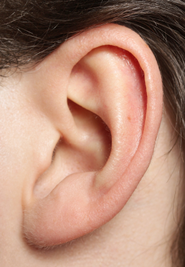Ear Surgery (Otoplasty)
 Otoplasty, or ear surgery, is a cosmetic procedure to improve the appearance of a person's ears. Although otoplasty does not affect hearing, it can provide great psychological benefits to anyone who has been teased about the size or shape of their ears, has had a serious ear injury, or simply wants to be more attractive. Otoplasty is most commonly performed to set unusually prominent ears back closer to the head, called ear pinning or to reduce the size of abnormally large ears. Ear surgery may also be helpful to repair the following conditions:
Otoplasty, or ear surgery, is a cosmetic procedure to improve the appearance of a person's ears. Although otoplasty does not affect hearing, it can provide great psychological benefits to anyone who has been teased about the size or shape of their ears, has had a serious ear injury, or simply wants to be more attractive. Otoplasty is most commonly performed to set unusually prominent ears back closer to the head, called ear pinning or to reduce the size of abnormally large ears. Ear surgery may also be helpful to repair the following conditions:
- Abnormal constructions, such as lop ear
- Cauliflower ear which results from repeated trauma
- Large, stretched, or torn earlobes
- Earlobes with large creases and wrinkles
- Microtia, or abnormally small ear formation
Surgeons are also able to construct new ears or parts of ears for patients who are missing them due to birth defect, severe injury, skin cancer or for some other reason.
Candidates for Otoplasty
Individuals who feel self-conscious about their ears and want to improve their appearance may be good candidates for otoplasty. While such operations are most frequently performed on children ages 4 to 14, they can be beneficial to people of any age. Ears are almost fully grown by age 4, and early surgery can help create self-confidence as a child begins to deal with the social complexities of school.
Not everyone is a good candidate for otoplasty. It is important for patients to be in good general health. Goals for the surgery should be carefully discussed with the surgeon prior to undergoing the procedure so that the patient has realistic expectations about the outcome.
The Otoplasty Procedure
The otoplasty procedure generally lasts two to three hours and is performed on an outpatient basis. The type of anesthesia used typically depends on the age of the patient. General anesthesia is recommended for very young patients, while local anesthesia and a sedative may be used for older children and adults.
The otoplasty procedure begins with a small incision made behind the ear, in the natural crease where the ear meets the head. The cartilage is then sculpted and bent into its new position to achieve the desired appearance. In some types of otoplasty, skin is removed but the cartilage is left in one piece and merely bent back on itself for a smaller-looking ear.
After sculpting the cartilage to the preferred shape, sutures and a bandage are used to hold the ear in its new position until healing is complete. To achieve a more symmetrical appearance, both ears may be operated on even if only one has a problem.
Recovery After an Otoplasty
Patients usually feel back to normal within hours after an otoplasty, although the ears may ache or throb for a few days. Prescription medication will be made available to help alleviate any discomfort. A few days after the otoplasty procedure, the bandages around the head will be replaced with a surgical dressing that should be worn for about a week after which time the stitches will be removed. Otoplasty patients should avoid sleeping on their side for the first two weeks after surgery.
After about one week following otoplasty, patients are usually able to return to their normal routines, children to school and adults to work. After the ears have healed completely, there will usually be a faint scar on the back of the ears. However, because of the strategic placement of the incisions in ear surgery, the scars will be virtually invisible and will typically fade with time.
To view our photo gallery of before and after examples, please click here.








If you would like more information about Ear Surgery or to schedule an appointment, feel free to fill out our convenient contact form or call us directly at 301.982.0202.